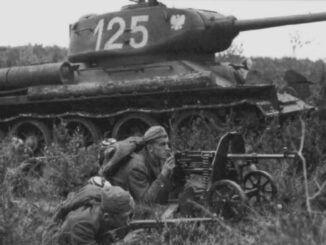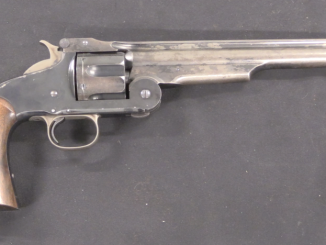One would think that the Shpagin PPSh-41 was as simple as a submachine gun could get, but that wasn’t the case in World War Two USSR. Barely had the PPSh gotten into real production than the Army was looking for something even simpler. An answer came from young designer Aleksey Sudaev with a completely-stamped gun that used about half the raw material and a third the machine time to produce as the PPSh. After winning the competitive trials, Factory 828 in Moscow was chosen as the lead production facility. They produced a series of drawings and preproduction guns in the summer of 1942.
Sudaev took those drawings into besieged Leningrad with orders to et up production in three factories within the city. The main one was Factory 209, and after fixing a few minor design flaws, the gun went into production in the spring of 1943. Sudaev PPS-42 SMGs pretty much went out the doors of the factory and right into combat trying to break the siege of the city. In total, about 46,000 would be produced before that siege was finally broken.
Meanwhile, Factory 828 in Moscow put a higher priority on policing the design than on immediate production. They implemented a substantial number of improvements, although the lack of communication into Leningrad prevented them from being used in the production going on there. Instead, the improvements culminated in the PPS-43 design, of which more than a million were made by the end of the war.




“(…)Barely had the PPSh gotten into real production than the Army was looking for something even simpler.(…)”
Whilst this was factor, main concern was to get lighter, more compact weapon, https://modernfirearms.net/en/submachine-guns/russia-submachine-guns/ppsh-2-eng/ describing competitor namely Shpagin PPSh-2 does claims
…requirements, issued by GAU (General Artillery Department of the Red Army General staff) for a new submachine gun, which should be handier, lighter and more compact than then-standard PPSh-41 submachine gun…
Moreover PPS ultimately wins, even though PPSh-2 was less time consuming than PPS, according to https://warspot.ru/4083-dolgaya-doroga-korotkogo-pps gives following values:
PPS – 4,23 hours
PPSh-2 – 3,8 hours
I concur that the PPS 42 was not initially intended as a replacement for Shpagin’s gun, and indeed it never did replace the PPSh 41. The 1942 trials were arranged with the idea of adopting something similar to the MP 40 for issue to specialist troops who required a compact SMG, such as tankers and paratroopers. Although issues had been raised with the PPSh 41 by that point, there was no intention to cancel production of the PPSh in favour of the PPS.
The situation in Russia was very similar to Italy, where the Royal Army arranged trials in 1943 to adopt an MP 40 clone for pretty much the same reasons. This resulted in the conception of the Beretta Mod. 38/43, the FNA-B Mod. 43, and the TZ 45 (then called the PMZ Mod. 43).
Not certainly in that way. It was originally planned that the new submachine gun would replace the PPSh. The People’s Commissar for Armaments promised to give two factories for this production. But the intrigues in the creation of a new submachine gun destroyed these plans. The Sudayev submachine gun was never produced at the factories of the People’s Commissariat of Armaments. When in 1943 it was proposed to replace the PPSh with a version of the Sudayev submachine gun with a wooden butt (as was later done in Poland), this proposal was rejected.
The story of Leningrad is part of the intrigue. Stalin’s order forbade early trials at the front. The weapons were to be tested in the depths of the country. In the divisions of the army, which were taken from the front for reorganization. GAU used production in Leningrad to gain an advantage. Soldiers at the front received new Sudaev submachine guns, but could not compare them with the new Shpagin submachine guns.
A long time ago, someone in Special Forces told me that Sudaev did something in Leningrad that got him onto a blacklist with Stalin or the NKVD, and that was why he didn’t get the medical care he needed after something that he picked up while in Leningrad killed him. I want to say it was TB…?
Anyhow, the gist of it was that Sudaev’s fate was tied into politics. I hadn’t realized that those problems dated as far back as the trials for his submachinegun, and I do wonder if the reason he was (supposedly…) denied modern antibiotics for his TB hadn’t something to do that whole issue, along with whatever happened in Leningrad.
Of course, all that dates back to well before the Wall came down, and everything inside the old Soviet Union was very much like the shadows in Plato’s Cave. Nobody here in the West knew anything really definitive, so the blanks were filled in with all sorts of BS that may or may not have simply been made up, let alone misinterpreted from evidence. This is why we still call it the AK-47 here in the West, when that nomenclature really isn’t at all accurate…
“(…)why he didn’t get the medical care(…)”
https://ru.wikipedia.org/wiki/%D0%A1%D1%83%D0%B4%D0%B0%D0%B5%D0%B2,_%D0%90%D0%BB%D0%B5%D0%BA%D1%81%D0%B5%D0%B9_%D0%98%D0%B2%D0%B0%D0%BD%D0%BE%D0%B2%D0%B8%D1%87 report cause of death as Язвенная болезнь желудка (I do not know proper English term) which is most often effect of Helicobacter pylori, to my knowledge effective eradication method of Helicobacter pylori simply did not exist in 1940s.
I’ve never heard this and I doubt it’s true. Sudayev died of a stomach ulcer and by all accounts he was still well revered at the time of his death. He was awarded the Stalin State Prize in 1946.
Stalin wasn’t shy about bumping off arms designers who failed to meet expectations. Look what happened to Yakov Taubin. As far as I am aware, there is no reason to think Sudayev’s death was suspicious.
“…no reason to think Sudayev’s death was suspicious.”
Of course not. It’s Russia…
and what about dictator Franco, he also died in Soviet Union? there were many of people who died because of the stomach ulcer. and Sudayev was rare and very valueble engeneer for the soviet state. btw epstein had to commit suicide twice even under 24/7 h supervision… people from babana state want to critisize others? 😀 😀
“(…)Of course not. It’s Russia…”
So who, according to your hypothesis has motive and opportunity to induce A.S.Sudayev death in 1946?
ss: “(…)A.S.Sudayev(…)”
should be: “(…)A.I.Sudayev(…)”
30 million people died in Soviet Union from ww2 causes, and not every one of them on the battlefield, so dying from disease or starvation among that huge chaos there was not uncommon.
During US civil war, most of the soldiers died from disease, at least if you ask dr. Gatling…
Tyrsegg’s Law: The chance of a Yank meeting a suspicious end is in direct proportion to the square of the distance from the nearest Clinton. (Enjoy yer “freedom” ya fucks and stooges))
Like I said, this dated back to the mid-1980s. Everything we knew about Soviet small arms was filtered through a variety of sources, and much of it was supposition, rumor, or outright falsification. I’m sure that there was something, somewhere, in print that the SF guys had access to that described Sudaev’s death and the reason for it very inaccurately. Whose fault was that? Nobody’s, really. We just didn’t know.
What I’m basically reporting is what people thought, here in the US, back in the day. It obviously wasn’t ground truth, but there you are.
One does wonder what another few hundred years of “historical telephone” will wind up getting put down as “recorded history”. It was eye-opening seeing Othais report on the issues he was having pinning down something as seemingly well-documented as the development of the revolver in Western Europe. You have to wonder what’s going to be in the history books for sourcing, years from now. If they rely on mid-1980s US Army SF training resources…? Yikes. There are gonna be some serious distortions when it comes to Soviet weapons, I suspect. This would be one of them.
On the other hand, I don’t know where that instructor got his info. It might not have been in the official manuals; he might have researched it outside official sources, and/or just made stuff up. Wouldn’t be the first or the last time that happened.
“(…)wonder what’s going to be in the history books for sourcing, years from now. (…)”
Depend on author and targeted audience, also whilst some sources might be lost time, another might be unearthed, take for example STENDEC case
https://en.wikipedia.org/wiki/1947_BSAA_Avro_Lancastrian_Star_Dust_accident
various bombastic explanation were proposed, including abduction by alien beings, after wreckage was found it was found to be CFIT, so reason was dull: navigation error.
Modern antibiotics didn’t exist in wwii
Fleming et al would be surprised to hear that…
Well, no antibiotic modern enough to treat h.pylori, which was not properly identified until 1982. Wikipedia says it was previously only known only as a “spiral-shaped bacteria” found at biopsies and autopsies. Daewoo’s term Язвенная болезнь желудка means “stomach ulcers.” Sudayev’s death must have been very painful and horrifying in one so young, and I bet an accelerating factor was the hardship of living in Leningrad while under siege. Fascinating to see both weapons side by side here.
“Sudayev’s death must have been very painful and horrifying”
– it depends on the exact mechanism of his demise. A peptic ulcer may kill in two basic ways – perforation and peritonitis (painful and kind of prolonged) or bleeding from an eroded artery (relatively quick and painless).
This is an urban legend. Alexei Sudayev died in the Kremlin hospital. He received the best treatment available in the USSR at the time.
After the creation of the submachine gun, he was considered one of the most promising designers. His Avtomat Sudayev AS-44 was recognized as the best at the first stage of the competition. With a high probability, he could win it with his new design.
Congratulation Ian, this gun is really rare, even in ex socialistic states. btw it was not russian, but soviet commision. russians were the main victims of the bolsheviks who used to me maily contain minorieties. especially one minority.
anyway Sudayev was young adventurer with interesting life.
I would be happy to see you shooting this rare piece. as a member of western colony in central europe and a poor slave of western corporation, i am now ever considering to send you some money 😀
I wonder how this very gun made its way to the US, from once-besieged Leningrad?
A German war trophy then liberated by a GI? Or a dodgy sale straight from Russia, during the marvellous mid-1990′?…
the first one, probably, due its status “fully transferable”. I guess only.
..good point! (we miss such subtleties here, in the UK; everything which makes rat-tat-tat-tat is soundly banned). This notwithstanding, this very gun has to have an interesting ‘personal’ story. Sadly, it cannot speak…